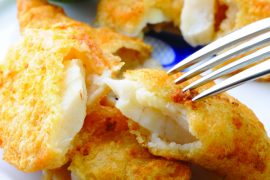By Bill Turner
It seems like every time you turn around, there is a new diet to try. It’s like a trip down memory lane remembering all the weight loss plans of the last 20 years – Atkins, Paleo, South Beach, Mediterranean, Weight Watchers, Zone, DASH, fasting, etc. It never stops and now we have to come to terms with the latest one: the ketogenic diet, or keto, which is the new low-carb, high-fat fad.
Let me start by cutting to the bottom line: This is a compelling program that is worth trying.
SCIENTIFIC BACKGROUND
Since the 1960s when the FDA began promoting low-fat diets, Americans have been eating too many carbohydrates, especially processed ones with high glycemic indexes, which lead to sugar spikes in the bloodstream. Too many carbs signals our pancreas to produce insulin to decrease blood sugar levels, but that also produces renewed hunger pangs and the need for a quick fix with more carbohydrates. This is a truly vicious circle leading not only to obesity, but also to diabetes, as the insulin system “wears out.” This is the well-documented “carbohydrate- insulin,” model of obesity and diabetes.
The data is terrifying: “In 1960, 31% of U.S. adults were overweight and 13% were obese. Today, a whopping 70% are overweight — and more than a third fall into the obese category, where the risks of weight-related health problems are the most dire,” according to Dr. Josh Axe, author of “Keto Diet: Your 30-Day Plan to Lose Weight, Balance Hormones, Boost Brain Health and Reverse Disease.”
The Centers for Disease Control and Prevention reports that more than 100 million Americans have diabetes or prediabetes.
Most importantly, a study in the renowned medical journal The Lancet, looked at more than 135,000 adults in 18 countries and found that a high-carb diet was associated with a higher risk of mortality, whereas a high-fat diet was associated with lower death rates.
Somebody at the FDA must be saying “oops!”
The ’60s must have been the era of “fake nutrition science” because the FDA, while promoting carbohydrate consumption, also demonized fats, especially saturated fats, and dietary cholesterol, such as eggs. We now know that the FDA got it wrong in both cases.
Two mega-studies in 2016 and 2017 through the National Institutes of Health showed no relationship between consumption of saturated fat and heart disease. The FDA is expected to soon reverse its position on saturated fats. Large studies have also shown that dietary cholesterol doesn’t matter. If you consume more dietary cholesterol, for example, eat more eggs, your body produces less cholesterol and vice versa. The FDA has now officially said that dietary cholesterol is not a health factor. (We have written on this topic in past issues of this magazine: “The Resurgent Egg” – Spring 2018, At The Lake and “KISS Ribs” – Summer 2018, At The Lake.)
The ketogenic or keto diet has digested (pun intended) all of the recent nutrition information and come up with a low-carb, high-fat program that is very similar to the Atkins diet. Atkins was developed in the 1960s and struggled to gain popularity due to concerns about fat and dietary cholesterol, which we now know are unfounded. The keto diet is a new generation of the Atkins diet, like a new generation of the Ford Mustang.
The keto diet has two goals. The first is to help you lose weight. The second is to get you off the carbohydrate bandwagon for good before it kills you.
LOSING WEIGHT
Here’s how the proponents say that the keto diet helps you lose weight. Your body is designed to process carbs first. This is the easy fuel. So, getting back to Dr. Josh Axe and his best-selling book on the keto diet, he makes this analogy: “You can think of carbs as kindling for a fire; they catch quickly (leading to blood sugar spikes) but also disappear just as quickly (producing hunger pangs). If your diet fare consists of a high percentage of carbs, you will have trouble making it between meals and likely fall off the wagon.”
On the other hand, it is easier to diet, so the keto and Atkins gurus say, if your food source is mainly fat and protein. These are slower burning fuels – think of them as lumps of coal – harder to light but longer lasting with no blood sugar spikes. If you are going to diet, throw in a lump of coal, in other words: fat, not a stack of kindling (carbs) and you have a better chance of staying on your diet. Add in some high-quality fats and proteins, like grass-fed beef, organic foods, wild salmon, avocados, coconut oil and you will get more vitamins, minerals and phytonutrients, which may lead to a variety of health benefits in addition to weight loss.
When there are no carbs around, your multipurpose liver will begin to convert fat that is stored or consumed into fatty acids, called ketones, via a process called ketosis, which is the source of the diet’s name. If you are consuming mostly fat and protein, you can keep the “ketosis engine” running most of the time. Reduce your caloric intake and the body will find it easy to attack the fat in your “love handles.” This is the basic theory of the keto diet in terms of losing weight.
GETTING OFF THE CARBOHYDRATE BANDWAGON
Probably the most compelling aspect of the keto diet is its basic proposition that we need to change the structure of the American diet away from carbohydrates and toward high-quality fats and proteins. In this way, you will give your pancreas and insulin system a break, help avoid diabetes and keep your weight in check.
The average American diet today consists of 50-60% carbohydrates. The keto diet proponents say that should be 5-10% during the initial weight loss period and 10-20% during the maintenance period. While the weight loss period can be a little tough, we can envision life at 10-20% carbs. That means a serving of pasta in the evening as long as we skimp on carbs for breakfast and lunch.
Note that neither the keto diet nor any diet says that you can eat as much as you want. Calories do count and always will. Diets really only differ in what you eat, not how much. The keto diet greatly reduces all carbs, especially processed and high glycemic foods. It pushes you to eat more nutrient-rich and high-energy foods and the proponents say that the plan is built around delicious foods that melt off fat, reduce your sugar cravings and help you feel mentally sharp, energetic and sated.
The keto diet gurus will claim “promising studies” showing that the diet lowers cholesterol, fights heart disease and cancer, reduces inflammation and improves brain function. All of that is still in the to-be-determined stage. What we do know is that the keto diet is reportedly easy to follow since the dieter feels more satiated and is less likely to break protocol. We also know that moving away from carbs will probably help us avoid diabetes and improve general health. That’s enough for me! So, let’s see how we begin.
AVOID THESE FOODS
- Grains: wheat, corn, rice and cereals like oats
- Sugars: honey, agave, maple syrup, white or brown sugar
- High-carb fruits: apples, bananas, oranges, grapefruit
- Tubers: potato and yams
EAT THESE FOODS
- Meats: fish, beef, lamb, poultry, eggs and organ meats (chopped liver)
- Low-carb vegetables: spinach, kale, broccoli and cruciferous veggies
- High-fat dairy: hard cheeses, high-fat cream, butter, whole milk yogurt
- Nuts and seeds: macadamias, walnuts, sunflower seeds, peanuts, almonds
- Avocados and berries: raspberries, blackberries, blueberries
- Sweeteners: stevia, erythritol
- Fats: coconut oil, high-fat salad dressing, saturated fats
GETTING STARTED
The easiest way to get started with a keto diet is to review what you ate the previous day and see what carbs you can eliminate and what fats and proteins, if any, you can add. For example, I recently had ham and eggs for breakfast with two pieces of toast and orange juice. Easy, eliminate the toast and orange juice and add some avocado slices and a glass of whole milk.
For lunch, I had my usual turkey and cheese sandwich and a nice pile of Cape Cod potato chips. So, I can chop up the turkey and cheese, add some spinach, nuts, berries and salad dressing and ditch the bread and chips. Not so tough.
For dinner, I had prepared a really nice Indian meal with chicken curry, rice, naan flatbread, asparagus and broccoli. The keto revised meal would eliminate the rice and naan, which seems a little draconian, until I tried it the following day and still had a very enjoyable experience.
After a quick check, I realized that the carbs accounted for about 1,000 calories of the total 2,000 consumed, very close to the national average. I probably added back about 500 calories in keto-friendly food, but that is still a reduction of 500 calories. Since one pound is equal to 3,500 calories, I would lose a pound a week on this plan.
I think that I can do this!
MORE INFORMATION AND RECIPES
If you want more information on the keto diet, I highly recommend Dr. Josh Axe’s book: “Keto Diet: Your 30-Day Plan to Lose Weight, Balance Hormones, Boost Brain Health and Reverse Disease,” Little, Brown and Company, 2018. His website lists the best and worst foods to eat on a keto diet.
Or, try this website for easy keto diet recipes. Good luck!





